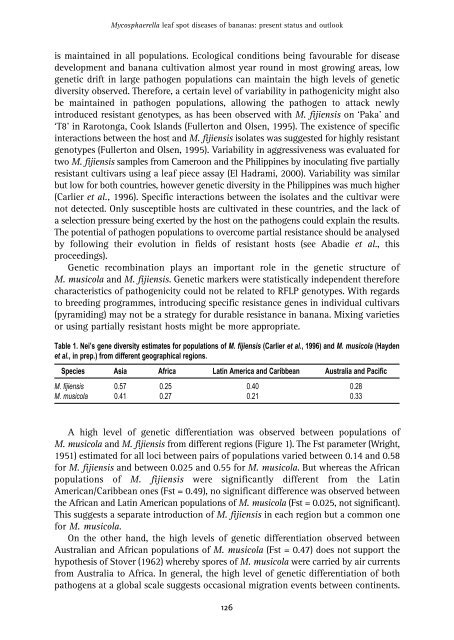Mycosphaerella leaf spot diseases of bananas - CBS
Mycosphaerella leaf spot diseases of bananas - CBS
Mycosphaerella leaf spot diseases of bananas - CBS
You also want an ePaper? Increase the reach of your titles
YUMPU automatically turns print PDFs into web optimized ePapers that Google loves.
<strong>Mycosphaerella</strong> <strong>leaf</strong> <strong>spot</strong> <strong>diseases</strong> <strong>of</strong> <strong>bananas</strong>: present status and outlook<br />
is maintained in all populations. Ecological conditions being favourable for disease<br />
development and banana cultivation almost year round in most growing areas, low<br />
genetic drift in large pathogen populations can maintain the high levels <strong>of</strong> genetic<br />
diversity observed. Therefore, a certain level <strong>of</strong> variability in pathogenicity might also<br />
be maintained in pathogen populations, allowing the pathogen to attack newly<br />
introduced resistant genotypes, as has been observed with M. fijiensis on ‘Paka’ and<br />
‘T8’ in Rarotonga, Cook Islands (Fullerton and Olsen, 1995). The existence <strong>of</strong> specific<br />
interactions between the host and M. fijiensis isolates was suggested for highly resistant<br />
genotypes (Fullerton and Olsen, 1995). Variability in aggressiveness was evaluated for<br />
two M. fijiensis samples from Cameroon and the Philippines by inoculating five partially<br />
resistant cultivars using a <strong>leaf</strong> piece assay (El Hadrami, 2000). Variability was similar<br />
but low for both countries, however genetic diversity in the Philippines was much higher<br />
(Carlier et al., 1996). Specific interactions between the isolates and the cultivar were<br />
not detected. Only susceptible hosts are cultivated in these countries, and the lack <strong>of</strong><br />
a selection pressure being exerted by the host on the pathogens could explain the results.<br />
The potential <strong>of</strong> pathogen populations to overcome partial resistance should be analysed<br />
by following their evolution in fields <strong>of</strong> resistant hosts (see Abadie et al., this<br />
proceedings).<br />
Genetic recombination plays an important role in the genetic structure <strong>of</strong><br />
M. musicola and M. fijiensis. Genetic markers were statistically independent therefore<br />
characteristics <strong>of</strong> pathogenicity could not be related to RFLP genotypes. With regards<br />
to breeding programmes, introducing specific resistance genes in individual cultivars<br />
(pyramiding) may not be a strategy for durable resistance in banana. Mixing varieties<br />
or using partially resistant hosts might be more appropriate.<br />
Table 1. Nei’s gene diversity estimates for populations <strong>of</strong> M. fijiensis (Carlier et al., 1996) and M. musicola (Hayden<br />
et al., in prep.) from different geographical regions.<br />
Species Asia Africa Latin America and Caribbean Australia and Pacific<br />
M. fijiensis 0.57 0.25 0.40 0.28<br />
M. musicola 0.41 0.27 0.21 0.33<br />
A high level <strong>of</strong> genetic differentiation was observed between populations <strong>of</strong><br />
M. musicola and M. fijiensis from different regions (Figure 1). The Fst parameter (Wright,<br />
1951) estimated for all loci between pairs <strong>of</strong> populations varied between 0.14 and 0.58<br />
for M. fijiensis and between 0.025 and 0.55 for M. musicola. But whereas the African<br />
populations <strong>of</strong> M. fijiensis were significantly different from the Latin<br />
American/Caribbean ones (Fst = 0.49), no significant difference was observed between<br />
the African and Latin American populations <strong>of</strong> M. musicola (Fst = 0.025, not significant).<br />
This suggests a separate introduction <strong>of</strong> M. fijiensis in each region but a common one<br />
for M. musicola.<br />
On the other hand, the high levels <strong>of</strong> genetic differentiation observed between<br />
Australian and African populations <strong>of</strong> M. musicola (Fst = 0.47) does not support the<br />
hypothesis <strong>of</strong> Stover (1962) whereby spores <strong>of</strong> M. musicola were carried by air currents<br />
from Australia to Africa. In general, the high level <strong>of</strong> genetic differentiation <strong>of</strong> both<br />
pathogens at a global scale suggests occasional migration events between continents.<br />
126

















